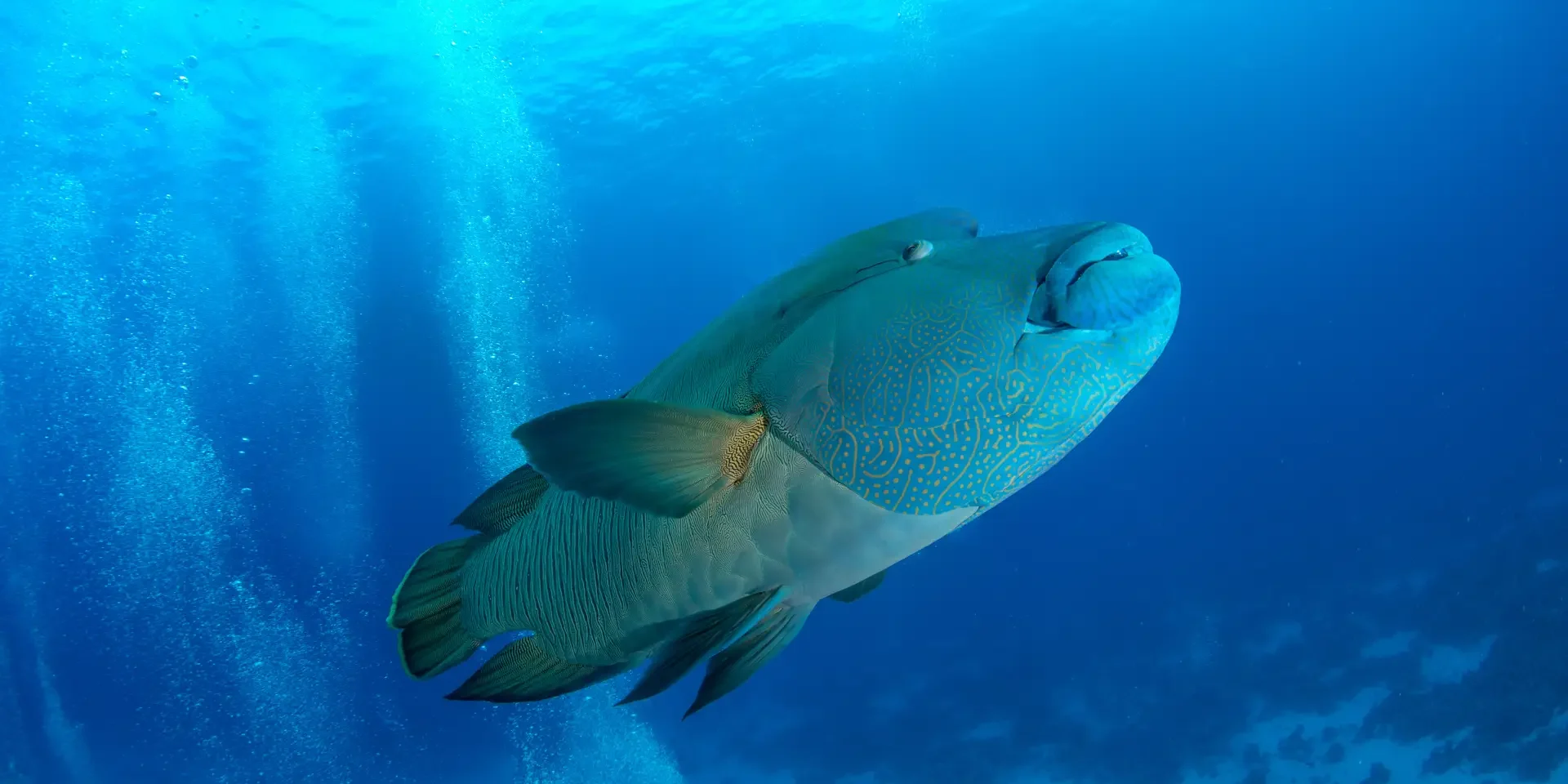The Napoleon Wrasse: Meeting the Red Sea’s Gentle, Intelligent Giant
There are moments in diving that transcend the ordinary. Moments that stay with you forever. One of those is the first time you lay eyes on a Napoleon Wrasse. It’s an experience that unfolds in graceful slow motion. A huge, majestic form materializes from the edge of the blue, not with the menacing speed of a predator, but with the calm, deliberate presence of a sentient being. Its large, expressive eyes seem to watch you, to acknowledge you. In that moment, you’re not just observing a fish; you’re having an encounter.
The Napoleon Wrasse, or Humphead Wrasse (Cheilinus undulatus), is one of the most iconic and sought-after sightings in the Red Sea. It is a true giant, a symbol of the wild, healthy reefs we are so privileged to explore. Here at Scubadore Hurghada, spotting one of these gentle giants is a highlight for both our guests and our guides, a reminder of the magic that awaits beneath the waves.
An Unmistakable Presence: How to Identify a Napoleon Wrasse
You’ll know a Napoleon Wrasse the second you see one. Their size alone is breathtaking. These are the largest members of the wrasse family, capable of growing to over two meters in length and weighing nearly 200 kilograms.
But it’s their distinctive features that make them truly unforgettable:
- The Napoleonic Hump: Mature males develop a large, prominent hump on their forehead, which gives the fish its common name due to its resemblance to the bicorne hat famously worn by Napoleon Bonaparte.
- Thick, Fleshy Lips: They have large, almost cartoonishly thick lips that are a key characteristic of the species.
- Intricate Facial Markings: Perhaps their most beautiful feature is the stunning pattern of intricate, maze-like lines that radiate from their eyes across their face. These markings are as unique as a human fingerprint, meaning no two Napoleons are exactly alike. Their colouration ranges from electric blues and greens to more subdued purplish hues.
The Intelligent and Curious Guardian of the Reef
What makes an encounter with a Napoleon Wrasse so special is the palpable sense of intelligence behind its eyes. These are not shy, skittish fish. They are known to be incredibly curious, often approaching divers to get a closer look. Experienced divers and guides who frequent the same reefs often report being recognized by individual wrasse, who will swim alongside the group like a gentle, oversized guide.
Beyond their charming personality, Napoleon Wrasse play a crucial role in maintaining the health of the reef. They are one of the very few predators of toxic marine species, including the infamous Crown-of-Thorns Seastar (COTS). By keeping COTS populations in check, the Napoleon Wrasse acts as a vital guardian, protecting the coral from being consumed by this destructive starfish. A healthy population of Napoleon Wrasse is often an indicator of a healthy, balanced reef ecosystem.
A Gentle Giant in Peril: A Story of Conservation
For all its size and presence, the Napoleon Wrasse is a fragile species facing a difficult future. The International Union for Conservation of Nature (IUCN) has listed the Humphead Wrasse as Endangered.
The primary threat to its survival is overfishing, particularly for the luxury live reef fish trade in parts of Asia. Their predictable spawning aggregations and curious nature make them an easy target. This makes the healthy population we have here in the protected waters of the Egyptian Red Sea incredibly precious.
This is where responsible dive tourism becomes a powerful conservation tool. A single Napoleon Wrasse, alive and thriving on the reef, is worth exponentially more to the local economy over its 30-year lifespan than it is once on a plate. As divers, by seeking out these encounters respectfully, we create a powerful economic incentive to protect these magnificent creatures and their habitat.
How to Have a Responsible and Rewarding Encounter
An encounter with a Napoleon Wrasse is a privilege. To ensure these interactions are positive for both diver and fish, we adhere to a strict code of conduct.
- Give It Space: This is the most important rule. Never chase, corner, or block the path of a Napoleon. The best encounters happen when you remain calm and still, allowing the fish’s natural curiosity to bring it closer to you.
- The Golden Rule: No Touching: Never attempt to touch a Napoleon Wrasse. Touching any marine animal can damage its protective mucus layer, leaving it vulnerable to disease.
- Do Not Feed Marine Life: Feeding fish disrupts their natural diet and behaviour, making them dependent on handouts and altering the delicate balance of the reef ecosystem.
- Control Your Buoyancy: Maintain neutral buoyancy and be aware of your surroundings to avoid accidental contact with the fish or the fragile coral reef it calls home.
- Dive with a Responsible Operator: The best way to see a Napoleon Wrasse is with a small, quiet group. Large, noisy groups of divers are more likely to intimidate and scare away these gentle giants. Our commitment at Scubadore Hurghada to small-group diving naturally creates a more respectful and intimate atmosphere, maximizing the chances of a truly magical encounter.
Where to Look for Napoleons in Hurghada
While a sighting is never guaranteed, Napoleon Wrasse tend to patrol the outer edges of reefs and drop-offs during the day. Dive sites near Hurghada with healthy coral ecosystems and access to deeper water, such as those around the Giftun Islands, are excellent places to keep an eye out for them.
The next time you descend into the blue with us, keep a watchful eye on the edge of the reef. You might just be rewarded with a visit from this intelligent, majestic, and endangered giant. An encounter with a Napoleon Wrasse is more than just a great photo opportunity; it’s a connection with a truly special individual, a memory that will stand as a highlight of your diving journey.







